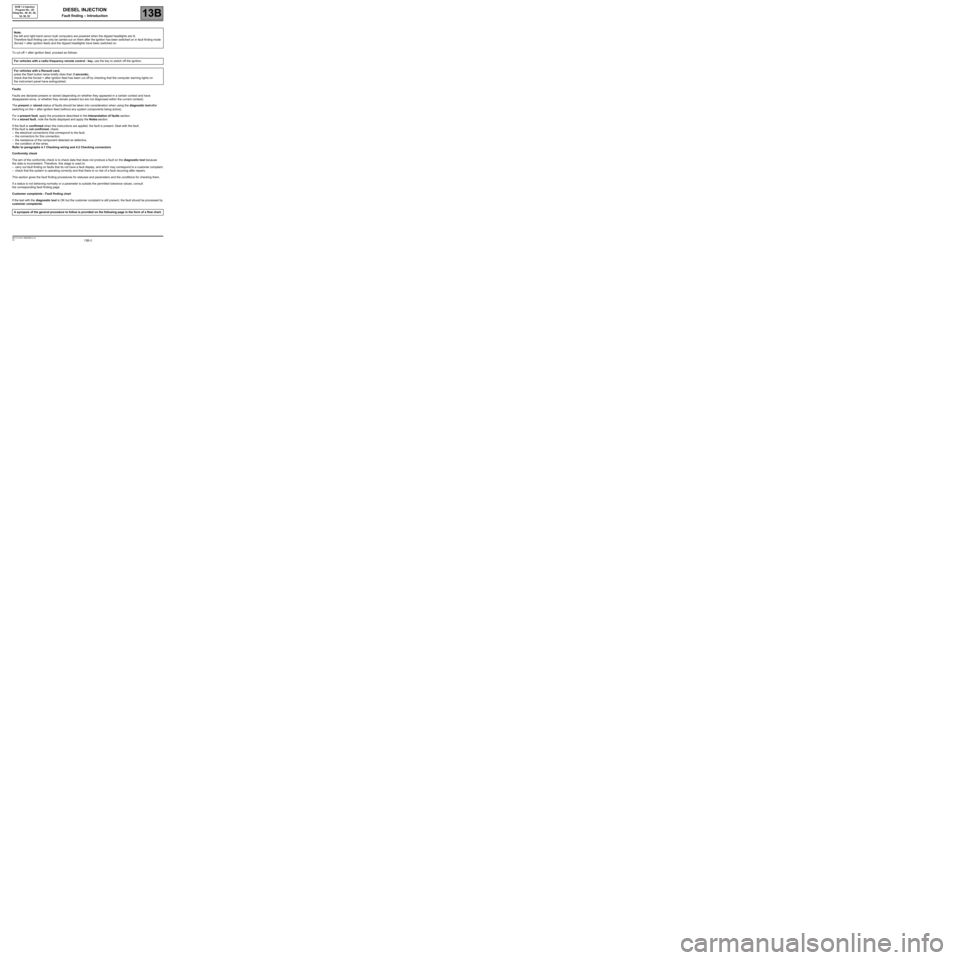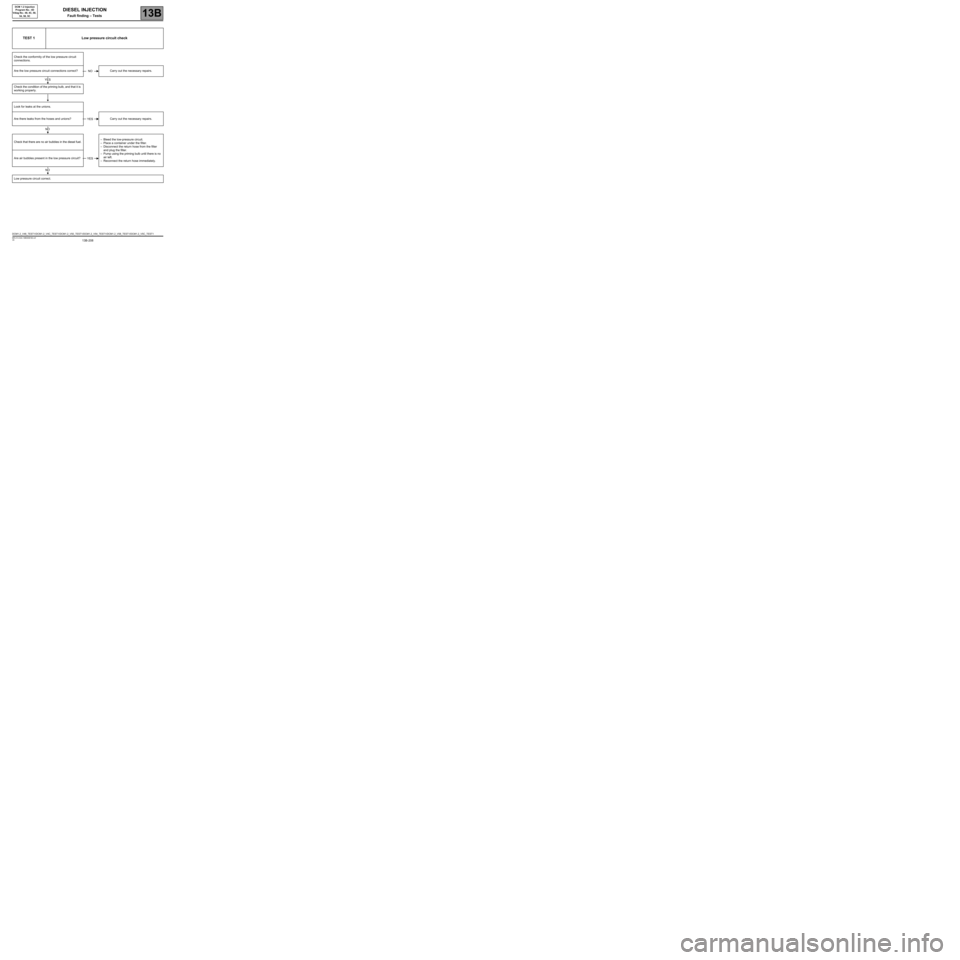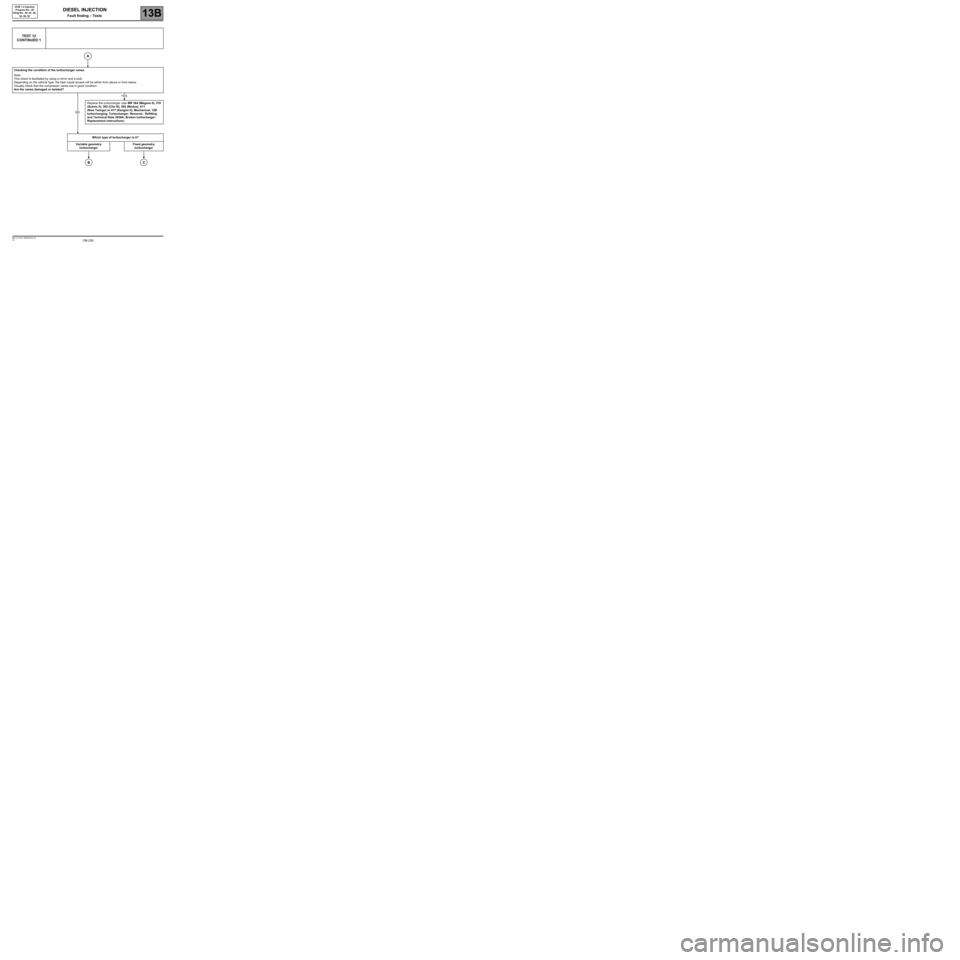bulb RENAULT TWINGO RS 2009 2.G Engine Diesel Injection Workshop Manual
[x] Cancel search | Manufacturer: RENAULT, Model Year: 2009, Model line: TWINGO RS, Model: RENAULT TWINGO RS 2009 2.GPages: 269
Page 3 of 269

13B-3V6 MR-413-X44-13B000$010.mif
DIESEL INJECTION
Fault finding – Introduction13B
DCM 1.2 Injection
Program No.: 4D
Vdiag No.: 48, 4C, 50,
54, 58, 5C
To cut off + after ignition feed, proceed as follows:
Faults
Faults are declared present or stored (depending on whether they appeared in a certain context and have
disappeared since, or whether they remain present but are not diagnosed within the current context).
The present or stored status of faults should be taken into consideration when using the diagnostic tool after
switching on the + after ignition feed (without any system components being active).
For a present fault, apply the procedure described in the Interpretation of faults section.
For a stored fault, note the faults displayed and apply the Notes section.
If the fault is confirmed when the instructions are applied, the fault is present. Deal with the fault.
If the fault is not confirmed, check:
–the electrical connections that correspond to the fault,
–the connectors for this connection,
–the resistance of the component detected as defective,
–the condition of the wires.
Refer to paragraphs 4.1 Checking wiring and 4.2 Checking connectors
Conformity check
The aim of the conformity check is to check data that does not produce a fault on the diagnostic tool because
the data is inconsistent. Therefore, this stage is used to:
–carry out fault finding on faults that do not have a fault display, and which may correspond to a customer complaint.
–check that the system is operating correctly and that there is no risk of a fault recurring after repairs.
This section gives the fault finding procedures for statuses and parameters and the conditions for checking them.
If a status is not behaving normally or a parameter is outside the permitted tolerance values, consult
the corresponding fault finding page.
Customer complaints - Fault finding chart
If the test with the diagnostic tool is OK but the customer complaint is still present, the fault should be processed by
customer complaints. Note:
the left and right-hand xenon bulb computers are powered when the dipped headlights are lit.
Therefore fault finding can only be carried out on them after the ignition has been switched on in fault finding mode
(forced + after ignition feed) and the dipped headlights have been switched on.
For vehicles with a radio frequency remote control - key, use the key to switch off the ignition.
For vehicles with a Renault card,
press the Start button twice briefly (less than 3 seconds),
check that the forced + after ignition feed has been cut off by checking that the computer warning lights on
the instrument panel have extinguished.
A synopsis of the general procedure to follow is provided on the following page in the form of a flow chart.
Page 208 of 269

13B-208V6 MR-413-X44-13B000$190.mif
DIESEL INJECTION
Fault finding – Tests13B
DCM 1.2 Injection
Program No.: 4D
Vdiag No.: 48, 4C, 50,
54, 58, 5C
TEST 1 Low pressure circuit check
Check the conformity of the low pressure circuit
connections.
Are the low pressure circuit connections correct? Carry out the necessary repairs.
Check the condition of the priming bulb, and that it is
working properly.
Look for leaks at the unions.
Are there leaks from the hoses and unions? Carry out the necessary repairs.
Check that there are no air bubbles in the diesel fuel.–Bleed the low-pressure circuit.
–Place a container under the filter.
–Disconnect the return hose from the filter
and plug the filter.
–Pump using the priming bulb until there is no
air left.
–Reconnect the return hose immediately. Are air bubbles present in the low pressure circuit?
Low pressure circuit correct.
NO
YES
YES
NO
YES
NO
DCM1.2_V48_TEST1/DCM1.2_V4C_TEST1/DCM1.2_V50_TEST1/DCM1.2_V54_TEST1/DCM1.2_V58_TEST1/DCM1.2_V5C_TEST1
Page 226 of 269

13B-226V6 MR-413-X44-13B000$190.mif
DIESEL INJECTION
Fault finding – Tests13B
DCM 1.2 Injection
Program No.: 4D
Vdiag No.: 48, 4C, 50,
54, 58, 5C
TEST 12
CONTINUED 1
Checking the condition of the turbocharger vanes.
Note:
This check is facilitated by using a mirror and a bulb.
Depending on the vehicle type, the best visual access will be either from above or from below.
Visually check that the compressor vanes are in good condition.
Are the vanes damaged or twisted?
Replace the turbocharger (see MR 364 (Mégane II), 370
(Scénic II), 392 (Clio III), 385 (Modus), 411
(New Twingo) or 417 (Kangoo II), Mechanical, 12B
turbocharging, Turbocharger: Removal - Refitting
and Technical Note 3938A, Broken turbocharger:
Replacement instructions).
Which type of turbocharger is it?
Variable geometry
turbochargerFixed geometry
turbocharger
A
NO
YES
BC